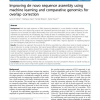2345 search results - page 7 / 469 » Comparing sequence scaffolds |
BMCBI
2010
13 years 7 months ago
2010
Background: With the rapid expansion of DNA sequencing databases, it is now feasible to identify relevant information from prior sequencing projects and completed genomes and appl...
BMCBI
2007
13 years 7 months ago
2007
Background: Features of a DNA sequence can be found by compressing the sequence under a suitable model; good compression implies low information content. Good DNA compression mode...
BMCBI
2007
13 years 7 months ago
2007
Background: In general, the construction of trees is based on sequence alignments. This procedure, however, leads to loss of informationwhen parts of sequence alignments (for inst...
BMCBI
2010
13 years 7 months ago
2010
Background: Microevolution is the study of short-term changes of alleles within a population and their effects on the phenotype of organisms. The result of the below-species-level...
SAC
2005
ACM
14 years 1 months ago
2005
ACM
There are today several systems for predicting transmembrane domains in membrane protein sequences. As they are based on different classifiers as well as different pre- and post-p...

